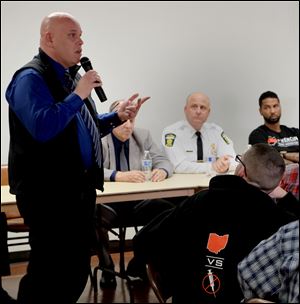
Access to synthetic opioids keeps overdose number climbing
2/18/2018
Despite a growing awareness of opioid epidemic, access to treatment, more law enforcement, and everyday citizens carrying the antidote naloxone, the number of fatal overdoses is growing in Ohio
ASSOCIATED PRESS
The toll of fatal overdoses only continues to climb, driven by an increase in potent, deadly synthetic opioids.
Despite a growing awareness of the problem, access to treatment, more law enforcement, and everyday citizens carrying the antidote naloxone, the number of fatal overdoses is growing in Ohio. A major contributing factor has been the increased potency of synthetic opioids.
In 2016 there were 4,050 fatal drug overdoses statewide. A majority of those deaths were attributed to opioids including heroin, fentanyl, and prescription drugs, according to the Ohio Department of Health.
Fentanyl and related drugs were involved in 58.2 percent of all unintentional overdose deaths in 2016, an increase from 37.9 percent in 2015. The synthetic opioid, which is up to 50 times more potent than heroin, was the cause of just 4 percent of overdoses in Ohio in 2013.
Heroin deaths remained flat in 2016 and prescription drug deaths declined for the fifth consecutive year, down to 564 — the fewest since 2009.
Those statewide trends are mirrored in the Toledo-area as well. In northwest Ohio, 2016 marked the first time fentanyl overtook heroin in fatal overdoses.

Dr. Robert Forney, chief toxicologist for the Lucas County Coroner’s office, said he’s seen overdoses go from prescription painkillers to heroin, then to fentanyl and its analogues, which have molecular structure similar to fentanyl.
Dr. Robert Forney, chief toxicologist for the Lucas County Coroner’s office, said he’s seen overdoses go from prescription painkillers to heroin, then to fentanyl and its analogues, which have molecular structure similar to fentanyl.
"[Now] they are almost always fentanyl or fentanyl analogues," Dr. Forney said of his caseload.
Across a 21-county region of northwest Ohio and southeast Michigan, 55 percent of deaths in 2016 included fentanyl. Another 10 percent were caused by fentanyl analogues. Only 35 percent were from heroin with no fentanyl detected, down from 91 percent in 2014.
Synthetic opioids are so deadly because it takes very little of the drug to overdose. The large animal tranquilizer carfentanil, for instance, he said, is measured in picograms, a unit of measurement that is one trillionth of a gram.
“I've heard people say ‘Imagine a grain of salt,’” Dr. Forney said, referring to how to imagine the small dosage that can be deadly. “But a grain of salt will weigh more than a picogram.” Most of his cases involving carfentanil would contain about 20 to 30 picograms, he said.

Drug Abuse Response Team's Lt. Robert Chromik, Jr.
The increased fatalities came as no surprise to Lt. Robert Chromik, who leads the Drug Abuse Response Team of the Lucas County Sheriff’s Office.
“We’re seeing more powerful synthetic analogues coming into the area,” he said at the time the 2016 numbers were released last year. “People are going to overdose or die faster.”
If you or someone you know is seeking treatment options and other resources, visit helpwithheroin.com or call 419-213-6582.
Contact Lauren Lindstrom at llindstrom@theblade.com, 419-724-6154, or on Twitter @lelindstrom.